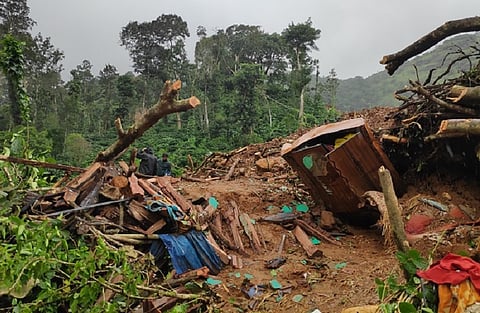

It is now over a month since landslides recurred in Karnataka's Kodagu district. "Mud from the top of the hill wiped out everything in its way in a matter of minutes," recalls Vijay Kumar, a resident of Thora village where a landslide claimed the lives of six people.
Landslides recurred in as many as five areas in Kodagu district in August, a year after the devastating landslides in the region in 2018, which killed 18 people and displaced over 7,000 others. Scientists attempting to find an answer to the recent spate of landslides in the region have now linked it to slope modification works in the district to construct roads and houses.
Geologists from the Geological Survey of India (GSI) studied surface cracks and landslides that occurred in Kodagu last month, killing at least 11 people. In a preliminary analysis, GSI scientists Sunandan Basu and Kapil Singh who visited Kodagu concluded that the cause of the landslides in the district was due to human modification of slopes.
Scientists also studied the rainfall pattern in the district and its link to the landslides. As many as five landslides were reported in the district in August in Talacauvery, Thora, Korangala, Ayyappa Hill and Virajpet-Heggala road while surface cracks were observed in three areas in Brahmagiri, Nehru Nagar and Ayyappa Hill.

Two of the landslides which occurred in Korangala and Thora villages after a spell of heavy rain on the morning of August 9 killed 11 people. The landslide in Korangala turned fatal for five members of a family. "The scientific causes of the landslide are slope cut for house construction, toe cutting of the slope by stream and reduction of strength of overburden material on super saturation," reads the analysis by GSI scientists. Toe cutting of slope by stream refers to erosion caused by water at the foot of a slope while landslides in the Western Ghats are attributed to deposits of overburden materials on slopes. These include loose soil, stones and debris, and such areas witness landslides in times of heavy rainfall.
GSI scientists could not study the landslide in Thora village due to adverse weather conditions. Ten people went missing after the landslide occurred and only six bodies have been recovered from the debris, one month after the disaster. Search operations were called off even though four people are still missing
"Due to wet weather condition and thick pile of debris, the main body of the landslide was inaccessible and only run out part at the valley could be approached," reads the report by GSI. For many days after the disaster, residents of Thora returned to the spot of the landslide to help with the search for survivors and dead bodies but after 23 days, the search operations were called off after district authorities took the consent of the families of the missing persons.
Meanwhile, the landslide on Virajpet-Heggala road that occurred on August 8 and the landslide near Talacauvery temple that occurred on August 9 were also linked to road construction in the area while the landslide in Ayyappa Hills was linked to the "construction of houses without proper support".